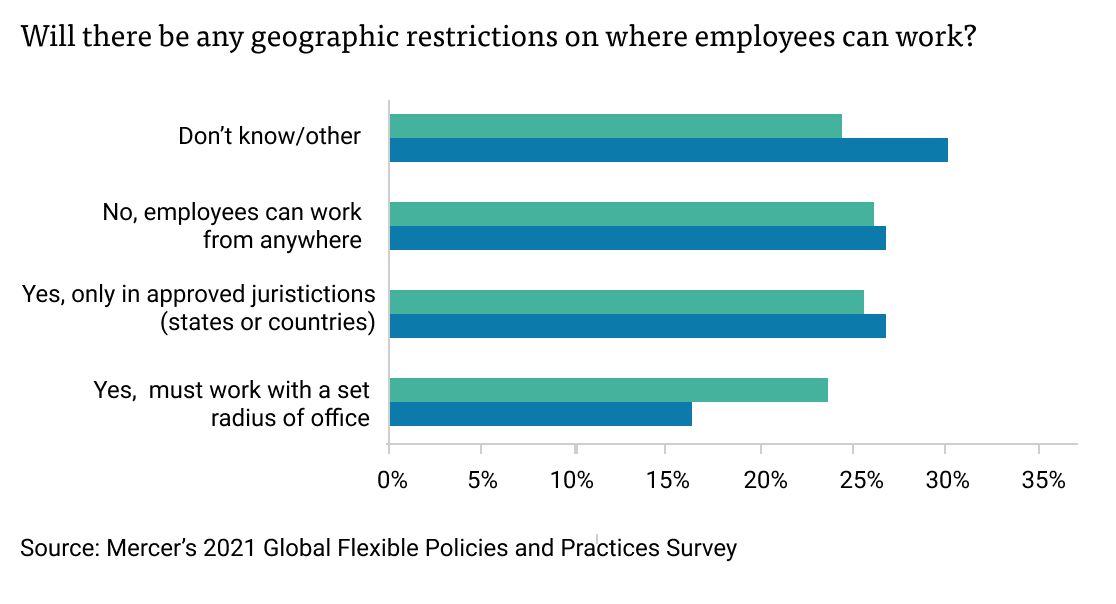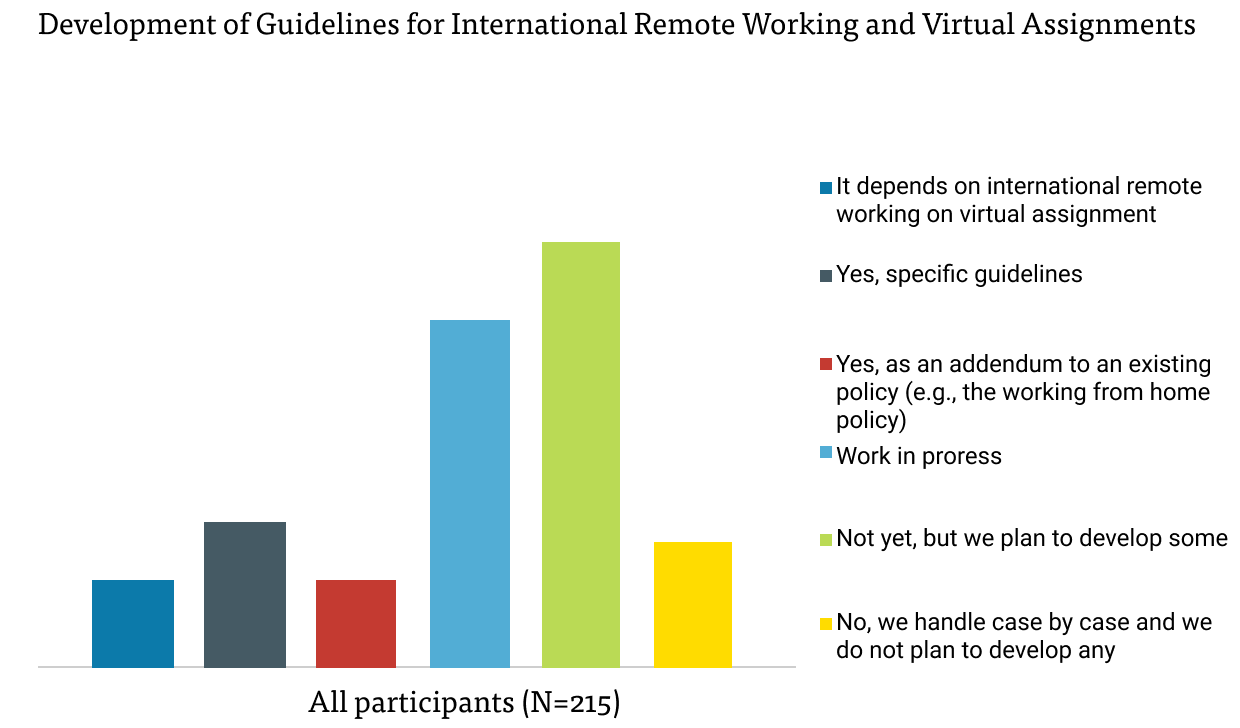The Challenges
International Remote Working
The expression “working from anywhere” has been used by CEOs and top-level managers. The risk is that the promise may remain vague and difficult to implement in practice.
Remote working has been introduced as a temporary measure during the pandemic, but the debate — whether or not it will be a permanent option for the workforce — is here to stay.
The expression “working from anywhere” has been used by CEOs and top-level managers to demonstrate the willingness of their organizations to become more flexible, agile and attuned to the expectations of their workers. It holds the promise of better employee experience and increased business resilience. The risk is that the promise may remain vague and difficult to implement in practice. Does it mean literally anywhere in the world, or are there restrictions? Is it applicable only within a given country due to compliance issues? Is the arrangement temporary or permanent? May employees work remotely some days and in an office on others, perhaps on a schedule they devise themselves? The risk of misunderstanding between stakeholders is significant.
Even organizations that are not willing to allow remote working going forward need to communicate about it and justify their decision. Companies that did embrace remote working now need to clarify their work setup and address the question of whether employees can work across borders.
Managing International Remote Working: A Work in Progress
Cross-border working adds a layer of complexities to the remote working debate. Compliance issues related to tax, social security, immigration and insurance have prompted HR teams to challenge requests from management about working from anywhere. Yet, while half of organizations forbid remote workers to work across borders, 25% truly allow work from anywhere and the remaining 25% have not clarified their point of view yet.
International remote working usually takes two forms: employee-driven international remote working — in other words, employees requesting to work across borders for personal reasons — and virtual assignments, a company-driven alternative to international assignments for employees who cannot relocate abroad.
Employee-driven international remote working is usually very short (a few weeks or a couple of months), but it can be indefinite. The objective is to allow employees more flexibility in terms of lifestyle and thus increase satisfaction and retention.
There may be a risk of having virtual assignees fly under the radar, triggering the same problems that companies experienced (and are still experiencing) with business travelers and commuters.
Company-driven virtual assignments are usually for a fixed duration and aim to address pre-defined business objectives that would normally be covered during an international assignment. They can be used as a stop gap measure if actual relocation is impossible.
These two forms of international remote working were often managed on an ad-hoc basis prior to the pandemic. Companies are now increasingly working on detailed policy guidelines to manage these new forms of work setup.
Decisions on a Case-by-Case Basis
The international remote working question does not lend itself to a simple yes or no. Assessing feasibility needs to be done on a case-by-case basis. International remote working may be feasible for one employee in a given location but problematic for another employee in a different situation.
Companies need to decide how much effort and resources they should invest in the option to work in an international remote position. In practice, it means establishing clear feasibility assessments and understanding how various scenarios will play out before moving forward.
Who Benefits from International Remote Work?
As international remote working cannot be universally applied without risks, what limitations and safeguards should be in place? Is there a need to add clauses in non-mobility policies (e.g., working from home policies) to clarify what happens if an employee asks to work across borders? HR and management need to reach a common understanding of what is allowed and send a clear message to employees.
Is the concept of a virtual assignment supporting clear objectives for the employee and the company, or is it just a reaction to an unexpected crisis situation? Is it in the interest of the business or of the employee or both? The answer to the latter question can help determine who should bear potential additional costs. Companies provide a more limited budget for self-requested moves than for business-essential international assignments.
The same logic could be applied to international remote working. Clarifying the intention is also about the long-term objectives and the duration of the assignments. Misreading or simply not checking the long-term intentions could trigger additional costs and problems down the line.
Anticipate and Address Potential Problems
Companies will also need to address potential awareness gaps related to the relocation of employees. There may be a risk of having virtual assignees fly under the radar, triggering the same problems that companies experienced (and are still experiencing) with business travelers and commuters.
Avoiding gaps could also be about anticipating the side effects of international remote working, such as the marginalization of specific employee groups that struggle with virtual work. Remote working can alleviate family issues and improve the well-being of many employees, but it may upset the work-life balance of others. In an international context, remote working can also reinforce cultural misunderstandings and loosen company culture.
While a CEO may promise employees can work from anywhere, it is important that companies have one shared definition of what “remote work” means. After that is established, leadership needs to understand the details of each employee’s assignment or request to work internationally on an individual basis.
Not all companies face the same remote working challenges, and therefore, there’s no one standard policy that can address international remote work for all companies. Remote work will look different for employees across companies and countries, meaning each organization needs to decide where its boundaries are.

The expression “working from anywhere” has been used by CEOs and top-level managers. The risk is that the promise may remain vague and difficult to implement in practice.
Source: Getty Images
Remote working has been introduced as a temporary measure during the pandemic, but the debate — whether or not it will be a permanent option for the workforce — is here to stay.
The expression “working from anywhere” has been used by CEOs and top-level managers to demonstrate the willingness of their organizations to become more flexible, agile and attuned to the expectations of their workers. It holds the promise of better employee experience and increased business resilience. The risk is that the promise may remain vague and difficult to implement in practice. Does it mean literally anywhere in the world, or are there restrictions? Is it applicable only within a given country due to compliance issues? Is the arrangement temporary or permanent? May employees work remotely some days and in an office on others, perhaps on a schedule they devise themselves? The risk of misunderstanding between stakeholders is significant.
Even organizations that are not willing to allow remote working going forward need to communicate about it and justify their decision. Companies that did embrace remote working now need to clarify their work setup and address the question of whether employees can work across borders.
Managing International Remote Working: A Work in Progress
Cross-border working adds a layer of complexities to the remote working debate. Compliance issues related to tax, social security, immigration and insurance have prompted HR teams to challenge requests from management about working from anywhere. Yet, while half of organizations forbid remote workers to work across borders, 25% truly allow work from anywhere and the remaining 25% have not clarified their point of view yet.
International remote working usually takes two forms: employee-driven international remote working — in other words, employees requesting to work across borders for personal reasons — and virtual assignments, a company-driven alternative to international assignments for employees who cannot relocate abroad.
Employee-driven international remote working is usually very short (a few weeks or a couple of months), but it can be indefinite. The objective is to allow employees more flexibility in terms of lifestyle and thus increase satisfaction and retention.
There may be a risk of having virtual assignees fly under the radar, triggering the same problems that companies experienced (and are still experiencing) with business travelers and commuters.
Company-driven virtual assignments are usually for a fixed duration and aim to address pre-defined business objectives that would normally be covered during an international assignment. They can be used as a stop gap measure if actual relocation is impossible.
These two forms of international remote working were often managed on an ad-hoc basis prior to the pandemic. Companies are now increasingly working on detailed policy guidelines to manage these new forms of work setup.
Decisions on a Case-by-Case Basis
The international remote working question does not lend itself to a simple yes or no. Assessing feasibility needs to be done on a case-by-case basis. International remote working may be feasible for one employee in a given location but problematic for another employee in a different situation.
Companies need to decide how much effort and resources they should invest in the option to work in an international remote position. In practice, it means establishing clear feasibility assessments and understanding how various scenarios will play out before moving forward.
Who Benefits from International Remote Work?
As international remote working cannot be universally applied without risks, what limitations and safeguards should be in place? Is there a need to add clauses in non-mobility policies (e.g., working from home policies) to clarify what happens if an employee asks to work across borders? HR and management need to reach a common understanding of what is allowed and send a clear message to employees.
Is the concept of a virtual assignment supporting clear objectives for the employee and the company, or is it just a reaction to an unexpected crisis situation? Is it in the interest of the business or of the employee or both? The answer to the latter question can help determine who should bear potential additional costs. Companies provide a more limited budget for self-requested moves than for business-essential international assignments.
The same logic could be applied to international remote working. Clarifying the intention is also about the long-term objectives and the duration of the assignments. Misreading or simply not checking the long-term intentions could trigger additional costs and problems down the line.
Anticipate and Address Potential Problems
Companies will also need to address potential awareness gaps related to the relocation of employees. There may be a risk of having virtual assignees fly under the radar, triggering the same problems that companies experienced (and are still experiencing) with business travelers and commuters.
Avoiding gaps could also be about anticipating the side effects of international remote working, such as the marginalization of specific employee groups that struggle with virtual work. Remote working can alleviate family issues and improve the well-being of many employees, but it may upset the work-life balance of others. In an international context, remote working can also reinforce cultural misunderstandings and loosen company culture.
While a CEO may promise employees can work from anywhere, it is important that companies have one shared definition of what “remote work” means. After that is established, leadership needs to understand the details of each employee’s assignment or request to work internationally on an individual basis.
Not all companies face the same remote working challenges, and therefore, there’s no one standard policy that can address international remote work for all companies. Remote work will look different for employees across companies and countries, meaning each organization needs to decide where its boundaries are.
Click here to add your own text
Click here to add your own text
Click here to add your own text





